#Karachi Education
Explore tagged Tumblr posts
Text
کراچی بورڈ کا تعلیمی بحران

کیا کراچی بورڈ سے انٹر سائنس اول کا امتحان دینے والے طلبہ کے لیے پیشہ وارانہ تعلیمی اداروں کے دروازے بند ہو جائیں گے؟ پہلے یہ سوال اخبارات کے صفحات پر نظر آیا اور پھر کراچی پریس کلب کے سامنے طلبہ اور ان کے والدین نے احتجاج کرتے ہوئے اٹھایا۔ اس سال بھی حسب روایت انٹرمیڈیٹ سال اول کے نتائج بہت دیر سے آئے۔ انٹر سائنس پری میڈیکل کا نتیجہ 36 فیصد رہا۔ انٹر سائنس پری انجنیئرنگ کا نتیجہ 34 فیصد کے قریب رہا۔ انجنیئرنگ اور میڈیکل کی تعلیم کے اداروں میں انٹرمیڈیٹ سال دوئم کے نتائج دیر سے آنے کی بناء پر وقت پر سیشن شروع کرنے کے لیے سال اول کے نتائج کی بنیاد پر مشروط داخلے دیے۔ پیشہ وارانہ اداروں میں داخلہ ٹیسٹ دینے کے لیے 60 فیصد سے زائد نمبر حاصل کرنا ضروری ہے، اگرچہ کراچی بورڈ کے نتائج کے مطابق دونوں فیکلٹیز کا نتیجہ 64 فیصد اور 60 فیصد رہا۔ اس بناء پر کراچی بورڈ سے پاس ہونے والی اکثریت میڈیکل اور انجنیئرنگ کے اداروں میں ناصرف داخلوں سے محروم ہو جائے گی بلکہ چین، روس، یورپی ممالک، امریکا اور کینیڈا کی یونیورسٹیوں میں کم اوسط نمبر ہونے کی وجہ سے داخلوں سے محروم بھی ہو جائے گی۔
کراچی پریس کلب پر ہونے والے مظاہروں میں طلبہ کے علاوہ طالبات کی بڑی تعداد بھی شریک ہو رہی ہے۔ ان احتجاجی طلبہ کا کہنا ہے کہ ان میں سے بیشتر طلبہ نے میٹرک کے امتحانات میں 80 سے 90 فیصد نمبر حاصل کیے مگر اب ان میں سے کئی طلبہ کو تین تین پرچوں میں فیل کر دیا گیا۔ اس مظاہرے میں شریک بعض طلبا و طالبات اتنے جذباتی تھے کہ وہ اس بات کا بلا روک ٹوک اظہارکر رہے تھے کہ ان کا مستقبل تباہ ہو گیا تو وہ اس بناء پر ان کے پاس خودکشی کرنے کے سوا کوئی اور چارہ نہیں ہو گا۔ جناح سندھ میڈیکل یونیورسٹی کے وائس چانسلر ڈاکٹر سراج میمن نے اس صورتحال پر تبصرہ کرتے ہوئے کہا کہ پری میڈیکل میں داخلے کے لیے کم از کم 60 فیصد نمبر لازمی ہوتے ہیں، اگر نتائج داخلہ کے کم از کم نمبروں سے کم ہیں تو اس کے اثرات میڈیکل کے تعلیمی اداروں کے داخلوں پر پڑیں گے۔ ایک سائنس کالج کے پرنسپل نے کہا کہ عام خیال یہ ہے کہ طالب علم سائنس کے بنیادی مضامین میں انتہائی کم نمبروں سے پاس ہوتے ہیں۔ وہ سال دوئم میں اتنے زیادہ نمبر حاصل نہیں کر پائے کہ 60 فیصد یا اس سے زیادہ کا ہدف حاصل کریں۔

اس صورت میں طلبہ سال اول کے مضامین کا دوبارہ امتحان دیتے ہیں، اگر پھر سال اول کا نتیجہ کم ہی رہا تو وہ اعلیٰ تعلیم سے یقینی طور پر محروم رہیں گے۔ ایک رپورٹ میں کہا گیا ہے کہ کراچی میں سائنس کی تعلیم کے کچھ کالجوں کا معیار ہمیشہ بلند رہا ہے۔ ان کالجوں میں پی ای سی ایچ ایس کالج، سرسید کالج ، گورنمنٹ کالج ایس آر مجید، سینٹ لارنس کالج، آدم جی کالج، ڈی جے سائنس کالج، اسلامیہ سائنس کالج، گورنمنٹ سائنس کالج، کینٹ اور پی ای سی ایچ ایس فاؤنڈیشن ش��مل ہیں۔ بہت سے تعلیمی بورڈز میں برسوں سے ایڈہاک بنیادوں پر تقرریوں سے کام لیا جا رہا ہے جس سے تعلیمی بورڈز کی مجموعی کارکردگی متاثر ہو رہی تھی۔ پیپلز پارٹی کی حکومت نے اپنی آئینی مدت کے آخری دنوں میں کچھ بورڈز کے چیئرمین، سیکریٹریز اور ناظم امتحانات کے تقرر کیے تھے۔ ان تقرریوں کے بارے میں یہ خدشہ ظاہر کیا جاتا تھا کہ یہ تقرریوں کا عمل شفاف طریقہ سے نہیں ہو رہا۔
سندھ ہائی کورٹ نے بورڈز کے بعض چیئرمین کے تقرر کو غیر قانونی قرار دیا مگر ان حکومتوں نے ان تقرریوں پر غور و خوص کیا اور کسی ذہین افسر نے یہ تجویز پیش کی کہ ڈویژنل کمشنروں کو تمام بورڈز کے چیئرمین کا چارج دیدیا جائے تو اب ڈویژنل کمشنر بورڈز کے نگراں بن گئے۔ یہ ایک ایسا فیصلہ تھا کہ جس کی صرف مذمت ہی ممکن ہے۔ پھر یہ رپورٹیں بھی شایع ہوئیں کہ کراچی انٹرمیڈیٹ بورڈ کے سیکریٹری اور ناظم امتحانات کے عہدے خالی پڑے ہیں۔ بعض رپورٹروں نے اپنی رپورٹس میں سارا معاملہ ڈویژنل کمشنر کا بورڈ کا چیئرمین بننے سے منسلک کر دیا، یہ بات حقیقت سے بالکل خلاف ہے۔ تمام ماہرین اس بات پر متفق ہیں کہ امتحانات میں بورڈ کے چیئرمین کا امتحانات میں کوئی کردار نہیں ہوتا۔ اردو یونیورسٹی کے سینئر استاد پروفیسر اصغر علی کا کہنا ہے کہ امتحانات کے انعقاد اور اس کے نتائج کا سارا کام ناظم امتحانات کرتا ہے۔ کنٹرولر امتحانات اور ان کا ذیلی عملہ ہی ممتحن کا تقرر، امتحانی پرچہ کی تیاری اور امتحانی کاپیوں کی جانچ کی نگرانی اور امتحانی نتائج کے اجراء کا ذمے دار ہوتا ہے اس بناء پر کمشنر پر اس کی ذمے داری عائد نہیں ہوتی مگر ماہرین اس بات پر بھی متفق ہیں کہ کمشنر کے پاس بے تحاشا ذمے داریاں ہیں۔
ان کے بجائے امتحانی کاموں کا برسوں تک فریضہ انجام دینے والے سینئر اساتذہ میں سے کسی استاد کو یہ ذمے داری سونپ دینی چاہیے۔ سینئر اساتذہ کا کہنا ہے کہ امتحانی کاپیوں کی جانچ کا کام کالجوں کے اساتذہ کرتے ہیں۔ اساتذہ کو امتحانی کاپیاں فراہم کرنے سے قبل کاپیوں پر خفیہ کوڈ تحریر کیا جاتا ہے۔ پہلے امتحانی کاپیوں کی جانچ پڑتال کے لیے سینٹر بنائے جاتے تھے مگر اساتذہ کو اب گھروں پر کاپیاں چیک کرنے کے لیے دی جاتی ہیں۔ ایک سینئر پرنسپل کا مشاہدہ ہے کہ نئے بھرتی ہونے والے اساتذہ کا معیار انتہائی پست ہے اور ان میں کاپیوں کی جانچ پڑتال کی اہلیت ہی نہیں ہے۔ اس معاملے کا گہرا تعلق کالجوں کی تعلیم سے مختلف ہے۔ اس حقیقت کا اعتراف کرنا چاہیے کہ اساتذہ باقاعدہ کلاس لینے کلاس رومز میں نہیں آتے، وہ طلبہ کو کوچنگ سینٹروں میں بلاتے ہیں جہاں لاکھوں روپے فیس کے وصول کیے جاتے ہیں۔ کالجوں میں طلبہ کی سو فیصد حاضری پر سختی سے عملدرآمد ہو گا، تو امتحانات میں بہتر نتائج مرتب ہو سکتے ہیں۔
بعض عناصر اس مسئلے کو لسانی شکل دینے کی کوشش کر رہے ہیں۔ ان کا کہنا ہے کہ کراچی کے طلبہ ک�� ساتھ طے شدہ منصوبے کے تحت زیادتی ہوئی ہے۔ دو سیاسی جماعتوں کے رہنماؤں نے اس مسئلے کو انتخابی مسئلہ بنانے کی کوشش کی ہے۔ کراچی بورڈ نے اس مسئلے پر تحقیقات کے لیے کور کمیٹی تشکیل دی ہے اس کی اہلیت پر بھی سوالات اٹھائے جا رہے ہیں۔ اس مسئلے کا حل ایک شفاف تحقیقات میں مضمر ہے۔ سندھ کے نگران وزیر اعلیٰ کو چاہیے کہ وہ سندھ ہائی کورٹ کے ایک جج پر مشتمل ایک اعلیٰ تحقیقاتی کمیشن کے قیام کے لیے گورنر کو تجویز پیش کرے جس میں ریٹائرڈ پرنسپل اور سینئر اساتذہ کو شامل کیا جائے۔ یہ کمیشن اگر محسوس کرے تو دوسرے بورڈ کی کاپیوں کی جانچ پڑتال کے بارے میں بھی تحقیقات کرے۔ سیاسی جماعتوں کا فرض ہے کہ اپنے انتخابی منشور میں انفارمیشن ٹیکنالوجی کے جدید آلات کے ذریعے امتحانات کے انعقاد کا وعدہ کریں۔ اس مسئلے کو تعلیمی مسئلہ ہی رہنا چاہیے۔
ڈاکٹر توصیف احمد خان
بشکریہ ایکسپریس نیوز
0 notes
Text
Which Degree to Pursue After Intermediate in 2024? A Guide for Students in Karachi
Choosing a degree after completing your intermediate education is a critical decision that can shape your career and future. With numerous options available, it’s essential to consider your interests, career goals, and the evolving job market. If you're in Karachi, you have access to several prestigious universities that offer a wide range of programs. This guide will help you navigate through your options and highlight some of the best universities in Karachi, including DHA Suffa University.
1. Engineering
Engineering remains a popular choice for many students due to its diverse specializations and promising career prospects. Common fields include Civil, Mechanical, Electrical, and Software Engineering.
Top Universities in Karachi for Engineering:
DHA Suffa University: Its top university in Karachi and Known for its modern campus and industry-focused programs.
NED University of Engineering and Technology: One of the oldest and most reputable engineering universities in Pakistan.
Sir Syed University of Engineering and Technology: Offers a wide range of engineering disciplines.
2. Business Administration
A degree in Business Administration (BBA) opens doors to various industries, from finance to marketing to human resources.
Top Universities in Karachi for Business Administration:
Institute of Business Administration (IBA): Renowned for its rigorous curriculum and strong alumni network.
LUMS: Though not in Karachi, it’s worth considering for its exceptional business programs.
DHA Suffa University: Offers a comprehensive BBA program with strong industry linkages.
3. Computer Science and IT
With the digital revolution, degrees in Computer Science and Information Technology are in high demand. These fields offer careers in software development, data science, cybersecurity, and more.
Top Universities in Karachi for Computer Science:
FAST-NUCES: Known for its strong emphasis on computer science and technology.
Karachi Institute of Economics and Technology (KIET): Offers specialized programs in IT and software engineering.
DHA Suffa University: Provides a state-of-the-art computer science program with hands-on learning opportunities.
4. Medicine and Health Sciences
For those inclined towards the medical field, degrees in Medicine, Dentistry, Pharmacy, and Allied Health Sciences are excellent choices.
Top Universities in Karachi for Medicine and Health Sciences:
Aga Khan University: Offers world-class medical education and research facilities.
Dow University of Health Sciences: A leading institution for medical and health sciences education.
DHA Suffa University: While primarily known for engineering and business, it is expanding its health sciences programs.
5. Social Sciences and Humanities
Degrees in Social Sciences and Humanities, including Psychology, Sociology, and International Relations, are ideal for students interested in understanding human behavior and societal issues.
Top Universities in Karachi for Social Sciences and Humanities:
University of Karachi: Offers a broad range of programs in social sciences and humanities.
Habib University: Known for its liberal arts education and interdisciplinary approach.
DHA Suffa University: Offers programs in social sciences that are integrated with modern teaching methodologies.
4 notes
·
View notes
Text
youtube
#Old Karachi History#old karachi#real karachi is lost#relive your past memories#how to erase your past memories#find your past life#your childhood memories#childhood memories#educational history#educational documentary#history of karachi city in urdu#history of karachi city#full documentary channel#documentary of karachi#your past memories#old area karachi#old karachi 1960#karachi history#history of karachi#partition of india#Before Partition#Youtube
0 notes
Text
STORY OF MISBAH SHABBIR AN UNDERPRIVILEGED STUDENT AT HOPE HIGH SCHOOL, ZIA COLONY, KORANGI.
This is the success story of Misbah Shabbir D/O Muhammad Shabbir, who belongs to Karachi. Misbah faced to tough time during her childhood, her mother had passed away she was very young, and her father is a labour who earns daily wage salary. Misbah has always had the interest in studies, she was a smart student, and used to get good grades, her father wanted her to study well, but could not…
View On WordPress
#Dr.Mubina Agboatwalla#Dr.Mubina Agboatwalla the child specialist in Karachi#Education#Health#HOPE#HOPE an educational NGO in Pakistan#HOPE an Health NGO in Pakistan#HOPE NGO in Pakistan#the child specialist in Karachi
0 notes
Text
Welcome to Karachi's premier study abroad consultancy – your trusted partner for seamless international education. Our expert team, recognized as top advisors, ensures a hassle-free journey. With vast experience, we've helped countless students realize their educational dreams, navigating applications, visas, and scholarships. Let us guide you to the right university and program for your academic and career goals. 🌐🎓
0 notes
Text
Revealing the Future of Education: An Unconventional Creative Exchange
Pioneering educator Rehan is cultivating global problem-solvers the world needs through hands-on creativity at his academy.
I recently connected with Rehan Allahwala, an innovative educator in Karachi pioneering new frontiers in education. Rehan’s school cultivates skills for the digital age through hands-on projects, empowering underprivileged youth. Each student receives a computer and internet access, nurturing self-directed learning through creativity, public speaking and content production leveraging AI. Within…

View On WordPress
#cross cultural exchange#education#future of education#future of learning#karachi#pakistan#rehan#rehan academy
0 notes
Text
اعلیٰ تعلیمی ادارے تباہی کے دہانے پر

پاکستان میں متوسط طبقہ کے لیے مہنگائی کے بعد اب تعلیم کا حصول بھی بڑا مسئلہ بن چکا ہے۔ پاکستانی طلبہ کی اکثریت جنھیں سرکاری تعلیمی اداروں میں اعلیٰ تعلیم حاصل کرنے کے مواقع میسر تھے، اب پہلے جیسے نہیں رہے اور حالات مزید تنزلی کی طرف جا رہے ہیں۔ اعلیٰ تعلیم سے متعلق ایک عرصے سے کوئی واضح اور مستقل تعلیمی پالیسی نظر نہیں آ رہی۔ ایسا محسوس ہوتا ہے کہ ملکی سیاسی منظر نامے کے تبدیل ہوتے ہی اعلیٰ تعلیمی اداروں کے اہم عہدیدار بھی تبدیل ہوتے ہیں اور اس تبدیلی کے ساتھ ہی تعلیمی پالیسیاں بھی تبدیل ہونے لگتی ہیں۔ حال ہی کی ایک خبر کے مطابق ایک سابق وزیراعظم کی قریبی عزیزہ اعلیٰ تعلیمی ادارے کے اہم ترین عہدے سے فارغ۔ ظاہر ہے جس ملک میں تعلیمی پالیسیاں بھی کسی کرکٹ میچ کی صورتحال کی طرح تبدیل ہوں وہاں تعلیمی معیار کیونکر عالمی سطح کا ہو سکتا ہے؟ غیر ملکی تعلیمی اداروں سے فارغ التحصیل جب ملکی تعلیمی پالیسیوں میں اپنا حصہ ڈالتے ہیں تو انھیں اس ملک اور اس کے طلبہ کی ضروریات اور حالات کا قطعی علم اور احساس نہیں ہوتا اور نہ ہی وہ تعلیمی پالیسیوں کو مرتب کرتے وقت متعلقہ ’’اسٹیک ہولڈرز‘‘سے مشورہ لیتے ہیں، چنانچہ ہم دیکھتے ہیں کہ تقریباً دو دہائیوں سے یہی طے نہ ہو سکا کہ جامعات میں آنرز اور ماسٹر کی ڈگریاں ہی اس ملک کے طلبہ کے مستقبل کا ضامن ہیں یا ’ بی ایس‘ کی؟
یہی کچھ حال کالجز اور پرائیویٹ اداروں کی ڈگریوں کے معاملات کا ہے، بات صرف یہی تک محدود نہیں ہے بلکہ حساس ترین اور اہم بات یہ ہے کہ اب سرکاری اعلیٰ تعلیمی اداروں کو کسی صنعتی ادارے یا فیکٹری کی طرح چلانے کا راستہ اختیار کر لیا گیا ہے اور تعلیمی اداروں کو پروڈکشن تیار کرنے یعنی مال کمانے والے ادارے کے طور پر چلانے کی بھر پور کوشش کی جا رہی ہے اور جامعات کی خودمختاری کو ختم کرتے ہوئے یہ باور کروایا جا رہا ہے کہ جامعات کا کام صرف پیسہ کمانا ہے فنڈز طلب کرنا نہیں۔ با الفاظ دیگر حکمرانوں کی جانب سے تعلیمی فنڈز فراہم کرنے کے بجائے ہاتھ کھڑے کر لیے گئے ہیں کہ جامعات کے اخراجات کے لیے حکومت کی طرف مت دیکھو، خود بندوبست کرو۔ سوال یہ ہے کہ جامعات تعلیم فراہم کرنے کا ادارہ ہوتی ہیں یا کسی فیکٹری کی طرح مال تیار کر کے، اسے فروخت کر کے پیسہ کماتی ہیں؟ حالیہ ایک خبر کے مطابق سندھ کے سیکریٹری یونیورسٹیز اینڈ بورڈز کے اجلاس میں جامعات سے کہا گیا کہ وہ اپنے اخراجات کو کم کریں اور ریسورس جنریشن کے دیگر ذرایع تلاش کیے جائیں۔ یہ بھی کہا گیا کہ جامعات میں ملازمین کی ضرورت سے زائد تعداد جامعات کے وسائل پر بوجھ ہے۔

حقیقت تو یہ ہے کہ تمام سرکاری اداروں میں تقرریاں سیاسی دباؤ کے تحت ہوتی ہیں جو ظاہر ہے کہ حکمرانوں کی جانب سے ہی ہوتا ہے تو اس کو ختم کرنا بھی حکومت کی ہی ذمے داری بنتی ہے۔ اسی طرح یہ کہنا کہ آیندہ تقرریاں بغیر پنشن کی بنیاد پر دی جائیں۔ سوال یہ ہے کہ جب آپ ایک استاد کو گھر چلانے کے لیے مناسب مشاہرہ اور مراعات جو دیگر سرکاری اداروں کے ملازمین کو بھی دی جاتی ہیں، اس سے محروم کر دیں گے تو اس سے ایک اچھی کارکردگی کی توقع کیسے رکھیں گے؟ کیا ایک استاد مہنگائی کے اس دور میں اپنے گھر کے اخراجات پورے کرنے کے لیے دیگر جگہوں پر کام نہیں کرے گا؟ ایسے میں وہ طلبہ کوزیادہ وقت نہیں دے سکے گا اور نہ توجہ۔ اس ملک میں ایک طبقے کو تو ریٹائرمنٹ کے بعد بھی مراعات دی جائیں اور ایک استاد جو پوری قوم کو اپنے پاؤں پر کھڑا کرتا ہے اس سے پنشن کا حق بھی چھین لیا جائے؟ بات یہ ہے کہ موجودہ صورتحال میں بھی جامعات کے اساتذہ کو وہ حقوق نہیں مل رہے جو قانونی طور پر ان کا حق ہے، مثلاًبیشتر جامعات میں پنشن بند ہے، کچھ میں تنخواہیں پوری نہیں مل رہی ہیں اور اساتذہ پروموشن کے بغیر ریٹائر ہو رہے ہیں۔
ملک کی سب سے بڑی جامعہ کراچی ہی میں تین اساتذہ بغیر پروموشن کے ریٹائر ہو گئے، پروموشن ان کا حق تھا وہ اس معیار پر بھی پورے اتر تے تھے اور عدالت کی طرف سے اس ضمن میں ہدایات بھی تھیں، تب بھی ان اساتذہ کو پروموشن جو ان کا حق تھا نہیں مل سکا اور اب پنشن بھی نہیں مل رہی۔ اب پنشن کے بغیر تقرری کی بات کی جا رہی ہے جب کہ جامعات کے اساتذہ کو تو اس وقت بھی پروموشن کا حق حاصل نہیں کیونکہ عرف عام میں ہم جب پروموشن کا لفظ استعمال کرتے ہیں توعملاً اس کا مطلب یہ ہوتا ہے کہ اگر جامعہ نئی تقرری کا اشتہار دیتی ہے تو یہاں پہلے سے مستقل بنیادوں پر کام کرنے والا ایک استاد دوبارہ سے ایک نئے امیدوار کی حیثیت سے درخواست جمع کرائے اور اس تمام مراحل سے گزرے جس سے ایک باہر سے آکر درخواست دینے والا امیدوار گزرے۔ گویا جامعات کا کوئی استاد اگر زندگی میں بھی نئی آسامی (پوسٹ یا عہدے) کے لیے درخواست جمع نہیں کرائے گا تو ایسے ہی ریٹائر ہو جائے گا، اس کا کوئی پروموشن نہیں ہو گا خواہ اس کی بیس، پچیس سال کی سروس ہو۔ دوسری طرف ایک عام سرکاری ملازم کو پانچ سال بعد سنیارٹی کے پرموشن بھی ملتا ہے اور آفیسر گریڈ کے ملازم کو گاڑی، ڈرائیور بھی جب کہ جامعہ کے گریڈ انیس اور بیس کے پروفیسر کو نہیں ملتا۔
یہ صورتحال اعلیٰ سرکاری تعلیمی اداروں کو بہت تیزی کے ساتھ تباہی کی طرف لے جا رہی ہے جس کا سب سے زیادہ نقصان اس ملک کے مڈل کلاس طبقے کو ہو رہا ہے۔ جامعات ان حالات میں اپنے اخراجات پورے کرنے کے لیے مسلسل فیسوں میں اضافہ کر رہی ہیں جو ظاہر ہے کہ مڈل کلاس طبقے کے لیے مشکلات کا باعث ہے۔ پہلے ہی اس ملک میں سرکاری اسکولوں کی تباہی ہو چکی ہے جس کی وجہ سے وہ خاندان جو پرائیویٹ اسکولوں کی فیس ادا نہیں کر سکتے، ان کی ایک بڑی تعداد مدرسوں کا رخ کر رہی ہے جہاں وہ مڈل یا میٹرک تک تعلیم حاصل کرنے کے بعد دوبارہ سرکاری تعلیمی اداروں کا رخ کرتے ہیں تاکہ انھیں کوئی اچھا ذریعہ معاش مل سکے۔ اب بہت سے دینی مدارس نے بی بی اے، ایم بی اے اور میڈیا سائنسز میں بھی ڈگری کورسسز شروع کر دیے ہیں اور مڈل کلاس کی ایک تعداد اس طرف بھی جا رہی ہے، لیکن ایسے اداروں کی تعداد زیادہ نہیں ہے چنانچہ اگر ریاست کی طرف سے تعلیمی معاملات اور پالیسیوں کو سنجیدگی سے نہیں لیا گیا تو اس بات کا قوی امکان ہے کہ مڈل کلاس پر آیندہ اعلیٰ تعلیم کے دروازے تقریباً بند ہو جائیں گے جو ملکی ترقی اور مستقبل کے لیے بھی ایک خطرناک مرحلہ ہو گا۔
ڈاکٹر نوید اقبال انصاری
بشکریہ ایکسپریس نیوز
0 notes
Text

I think about this image a lot. This is an image from the Aurat March (Women's March) in Karachi, Pakistan, on International Women's Day 2018. The women in the picture are Pakistani trans women, aka khwaja siras or hijras; one is a friend of a close friend of mine.
In the eyes of the Pakistani government and anthropologists, they're a "third gender." They're denied access to many resources that are available to cis women. Trans women in Pakistan didn't decide to be third-gendered; cis people force it on them whether they like it or not.
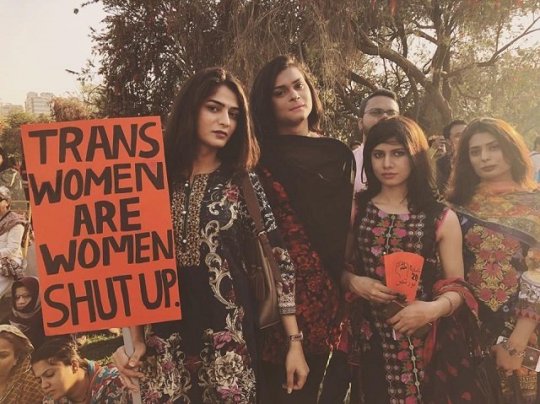
Western anthropologists are keen on seeing non-Western trans women as culturally constructed third genders, "neither male nor female," and often contrast them (a "legitimate" third gender accepted in its culture) with Western trans women (horrific parodies of female stereotypes).
There's a lot of smoke and mirrors and jargon used to obscure the fact that while each culture's trans women are treated as a single culturally constructed identity separate from all other trans women, cis women are treated as a universal category that can just be called "women."
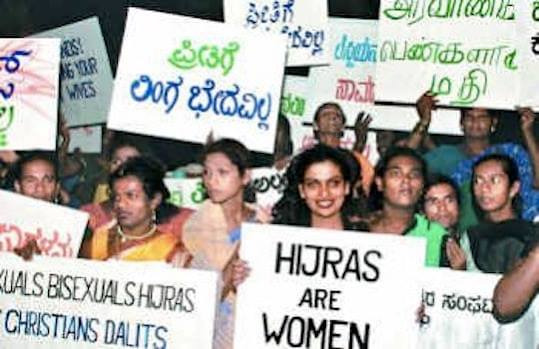
Even though Pakistani aurat and German Frauen and Guatemalan mujer will generally lead extraordinarily different lives due to the differences in culture, they are universally recognized as women.
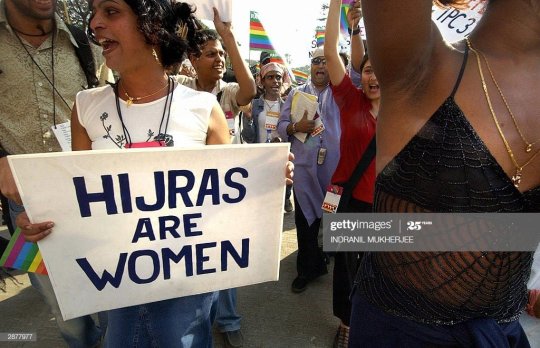
The transmisogynist will say, "Yes, but we can't ignore the way gender is culturally constructed, and hijras aren't trans women, they're a third gender. Now let's worry less about trans people and more about the rights of women in Burkina Faso."

In other words, to the transmisogynist, all cis women are women, and all trans women are something else.
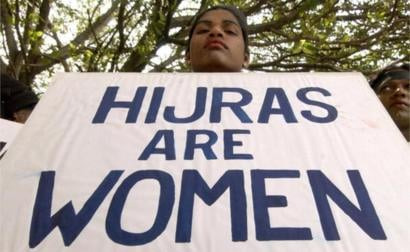
"But Kat, you're not Indian or Pakistani. You're not a hijra or khwaja sira, why is this so important to you?"
Have you ever heard of the Neapolitan third gender "femminiello"? It's the term my moniker "The Femme in Yellow" is derived from, and yes, I'm Neapolitan. Shut up.
I'm going to tell you a little bit about the femminielli, and I want you to see if any of this sounds familiar. Femminielli are a third gender in Neapolitan culture of people assigned male at birth who have a feminine gender expression.
They are lauded and respected in the local culture, considered to be good omens and bringers of good luck. At festivals you'd bring a femminiello with you to go gambling, and often they would be brought in to give blessings to newborns. Noticing anything familiar yet?
Oh and also they were largely relegated to begging and sex work and were not allowed to be educated and many were homeless and lived in the back alleys of Naples, but you know we don't really like to mention that part because it sounds a lot less romantic and mystical.
And if you're sitting there, asking yourself why a an accurate description of femminiello sounds almost note for note like the same way hijras get described and talked about, then you can start to understand why that picture at the start of this post has so much meaning for me.
And you can also start to understand why I get so frustrated when I see other queer people buy into this fool notion that for some reason the transes from different cultures must never mix.
That friend I mentioned earlier is a white American trans woman. She spent years living in India, and as I recal the story the family she was staying with saw her as a white, foreign hijra and she was asked to use her magic hijra powers to bless the house she was staying in.
So when it comes to various cultural trans identities there are two ways we can look at this. We can look at things from a standpoint of expressed identity, in which case we have to preferentially choose to translate one word for the local word, or to leave it untranslated.
If we translate it, people will say we're artificially imposing an outside category (so long as it's not cis people, that's fine). If we don't, what we're implying, is that this concept doesn't exist in the target language, which suggests that it's fundamentally a different thing
A concrete example is that Serena Nanda in her 1990 and 2000 books, bent over backwards to say that Hijras are categorically NOT trans women. Lots of them are!
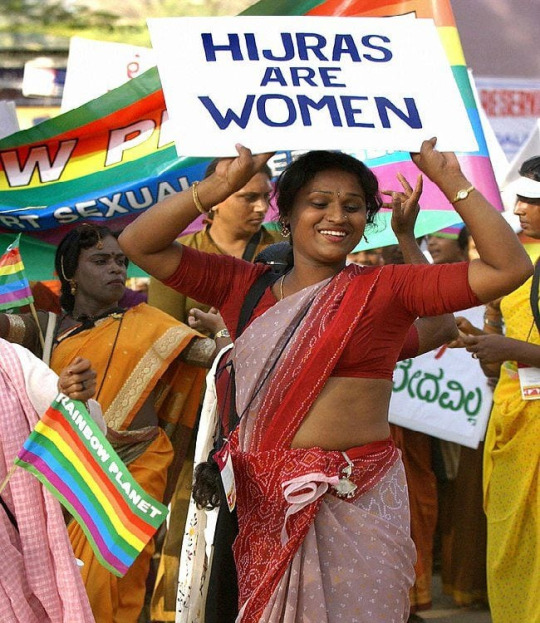
And Don Kulick bent over backwards in his 1998 book to say that travesti are categorically NOT trans women, even though some of the ones he cited were then and are now trans women.
The other option, is to look at practice, and talk about a community of practice of people who are AMAB, who wear women's clothing, take women's names, fulfill women's social roles, use women's language and mannerisms, etc WITHIN THEIR OWN CULTURAL CONTEXT.
This community of practice, whatever we want to call it - trans woman, hijra, transfeminine, femminiello, fairy, queen, to name just a few - can then be seen to CLEARLY be trans-national and trans-cultural in a way that is not clearly evident in the other way of looking at things.
And this is important, in my mind, because it is this axis of similarity that is serving as the basis for a growing transnational transgender rights movement, particularly in South Asia. It's why you see pictures like this one taken at the 2018 Aurat March in Karachi, Pakistan.
And it also groups rather than splits, pointing out not only points of continuity in the practices of western trans women and fa'afafines, but also between trans women in South Asia outside the hijra community, and members of the hijra community both trans women and not.
To be blunt, I'm not all that interested in the word trans woman, or the word hijra. I'm not interested in the word femminiello or the word fa'afafine.
I'm interested in the fact that when I visit India, and I meet hijras (or trans women, self-expressed) and I say I'm a trans woman, we suddenly sit together, talk about life, they ask to see American hormones and compare them to Indian hormones.
There is a shared community of practice that creates a bond between us that cis people don't have. That's not to say that we all have the exact same internal sense of self, but for the most part, we belong to the same community of practice based on life histories and behavior.
I think that's something cis people have absolutely missed - largely in an effort to artificially isolate trans women. This practice of arguing about whether a particular "third gender" label = trans women or not, also tends to artificially homogenize trans women as a group.
You see this in Kulick and Nanda, where if you read them, you could be forgiven for thinking all American trans women are white, middle class, middle-aged, and college-educated, who all follow rigid codes of behavior and surgical schedules prescribed by male physicians.
There are trans women who think of themselves as separate from cis women, as literally another kind of thing, there are trans women who think of themselves as coterminous with cis women, there are trans women who think of themselves as anything under the sun you want to imagine.
The problem is that historically, cis people have gone to tremendous lengths to destroy points of continuity in the transgender community (see everything I've cited and more), and particularly this has been an exercise in transmisogyny of grotesque levels.
The question is do you want to talk about culturally different ways of being trans, or do you want to try to create as many neatly-boxed third genders as you can to prop up transphobic theoretical frameworks? To date, people have done the latter. I'm interested in the former.
I guess what I'm really trying to say with all of this is that we're all family y'all.
#transgender#third gender#hijras#femminielli#trans women are women#trans solidarity#trans rights#transmisogyny#transunity#transunitism#this is what trans unity looks like
8K notes
·
View notes
Text
Nighat Dad grew up in a conservative family in Jhang, in Pakistan’s Punjab province. The threat of early marriage hung over her childhood like a cloud. But despite their traditional values, Dad’s parents were determined that all their children get an education, and they moved the family to Karachi so she could complete her bachelor’s degree. “I never really thought I would work, because I was never taught that we could work and be independent,” she says. “We always needed permission to do anything.”
Dad thought a master’s in law might delay the inevitable betrothal, but soon after she completed the course, she found out her parents had arranged a marriage for her. She didn’t mind her new life of domestic chores in a household she describes as “lower-middle class”—that is, until the abuse started. “That’s when my legal education reminded me that this was wrong,” she says. “Our laws, our constitution, everything protects me, so why was I facing this? Why was I tolerating it?”
With her family’s backing, Dad left her husband and filed for divorce. But after years of domestic violence and abuse and with no experience of working, she struggled with a lack of confidence. “I had no idea that women who are divorced and have a child face such difficulties in a society like ours,” she says. When her ex-husband filed a custody case for their 2-month-old baby, Dad wasn’t sure how she would pay for a lawyer. That’s when her father reminded her that she was a lawyer too.
Dad used her degree to win custody of her only child. In the process, she realized how many women in Pakistan were facing years of violence and systemic injustice. But the thing that bothered her most was the digital divide.
Before her marriage, Dad’s family never allowed her access to her own cell phone, and when she finally did get one, her husband would use it as a surveillance tool—keeping track of who she called and who was texting her. She had an escape tool in her hand, but she couldn’t use it. “Going through that by myself made me realize how quickly technology is evolving, and how it’s creating virtual spaces for marginalized communities that might not have access to physical ones,” she says. “Facing those restrictions made me understand just how crucial it is to challenge societal norms and structures around women's access to technology and the internet, so they can use it as freely as men.”
In 2012, Dad established the Digital Rights Foundation, an NGO that aims to address the digital divide and fight online abuse of women and other gender minorities in Pakistan. She began by helping women who reached out to the organization, providing advice on digital safety and emotional and mental support. In 2016—the same year Pakistan finally passed legislation against online crimes—Dad and her team launched a cyber-harassment helpline. Since 2016, it has addressed more than 16,000 complaints from across the country. “Sometimes, the police would give our phone numbers to victims seeking reliable help,” she says.
The DRF’s in-house legal team offers pro bono advice and helps women file and follow-up complaints against their abusers. “In many cases, we were successful in actually getting the perpetrator arrested and taken to trial,” Dad says. In October 2021, the DRF’s legal team helped journalist Asma Shirazi win a landmark case in the Islamabad High Court against broadcaster ARY News, after she became the target of a coordinated troll campaign which was exacerbated by a false story aired on the channel.
“If an organization like the DRF had existed when I was facing my own issues, I would have felt so much more supported—knowing there was someone to guide me legally and help me navigate the complexities,” she says. “My abuse started with surveillance, and if I had someone to talk to back then, I might have avoided the deep depression that followed. I might not have ended up in such a miserable situation.”
Today, Dad and the DRF are helping to steer global conversations about tech policy reform. She recently joined the United Nations’ AI Advisory Board, and was a founder member of Meta’s Oversight Board, which acts as an independent platform for people to appeal decisions made by the social media giant. “The emerging tech space is mostly driven by big Western companies and governments, leaving out civil society NGOs from the Global South,” she says. “This puts us far behind in global AI governance, always playing catch-up in a fast-moving world. If we’re not part of the conversation, the gap just keeps widening. It’s about reminding the powerful that they can’t win this race alone—they have a responsibility to include the rest of the world, especially those without the same resources.”
25 notes
·
View notes
Text
guys, if anyone still wants to join feel free to. im putting the link and meeting ID her, it will be held at 9pm GMT.
if you do choose to join, text me on tumblr and we can then discuss the prompt and oneshot on saturday.
(this is an exchange, attendance for a oneshot)
Topic: Project Zehnia - Education Conference
Time: Jan 18, 2025 02:00 AM Islamabad, Karachi, Tashkent
Join Zoom Meeting
https://us05web.zoom.us/j/8196592722?pwd=jL024U1ndQRAe5sEnsrNoZpZmH2348.1&omn=84875455779
Meeting ID: 819 659 2722
Passcode: Zehnia
thank you all.
#jegulus#james potter#marauders#marauders era#marauders fandom#regulus black#james fleamont potter#sirius black#remus lupin#aidenyaps#rosekiller#dorlene#wolfstar#marylene#prongsfoot#pandalily
10 notes
·
View notes
Text

Travel Destination: Pakistan
Written in the Stars by Aisha Saeed
Naila's conservative immigrant parents have always said the same thing: She may choose what to study, how to wear her hair, and what to be when she grows up-but they will choose her husband but when Naila falls in love with a boy Saif, her parents are livid and plan a vacation back to their homeland so Naila can reconnect with her roots.
However plans change and this vacation quickly turns to a nightmare when her parents find her a husband, Naila is running out of time, has Naila's fate been written in the stars? Or can she still make her own destiny?
Nura and the Immortal Palace by M.T. Khan
Nura must spend her time Mica mining for extra cash to support her family, however there’s rumours of treasure that could not only change her life but her family’s.
Her plan backfires when the mines collapse and four kids, including her best friend, Faisal, are claimed dead. Nura refuses to believe it and shovels her way through the dirt hoping to find him. Instead, she finds herself at the entrance to a strange world of purple skies and pink seas—a portal to the opulent realm of jinn, inhabited by the trickster creatures from her mother’s cautionary tales.
Under the Tamarind Tree by Nigar Alam
1964. Karachi, Pakistan. Rozeena is running out of time. She'll lose her home—her parents' safe haven since fleeing India and the terrors of Partition—if her medical career doesn't take off soon. But success may come with an unexpected price. Meanwhile the interwoven lives of her childhood best friends—Haaris, Aalya, and Zohair—seem to be unraveling with each passing day. The once small and inconsequential differences between their families' social standing now threaten to divide them. Then one fateful night someone ends up dead and the life they once took for granted shatters.
The Women’s Courtyard by Khadija Mastur
Set in the 1940s with Partition looming, Aliya dreams of educating herself and venturing beyond the courtyard walls, however she surrounded by the petty squabbles of her household.
Aliya must endure many trials before she achieves her goals, though at what personal cost?
An Abundance of Wild Roses by Feryal Ali-Gauhar
In a land woven with myth, chained with tradition and afflicted by war and the march of progress, the spirits of the mountains keep a baleful eye on the struggles of the villagers who scrape a living from the bodies of their wildlife. As the elements turn on the village, can humanity find a way to co-exist with nature that doesn't destroy either of them?
#booklr#world reading challenge#pakistan#book list#book rec#written in the stars#aisha saeed#m.t. khan#nura and the immortal palace#under the tamarind tree#nigar alam#the womens courtyard#Khadija Mastur#an abundance of wild roses#Feryal Ali-Gauhar#ya romance#contemporary#mg fantasy#historical fiction
11 notes
·
View notes
Text
youtube
#Old Karachi History#old karachi#real karachi is lost#relive your past memories#how to erase your past memories#find your past life#your childhood memories#childhood memories#educational history#educational documentary#history of karachi city in urdu#history of karachi city#full documentary channel#documentary of karachi#your past memories#old area karachi#old karachi 1960#karachi history#history of karachi#partition of india#Before Partition#Youtube
0 notes
Text

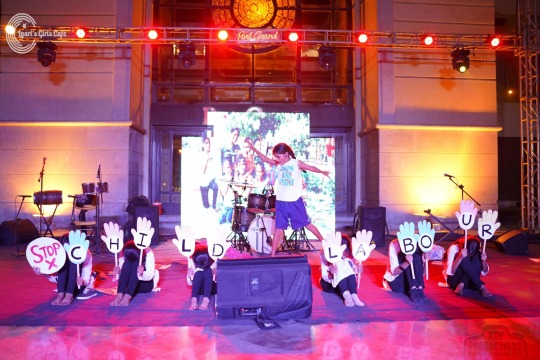
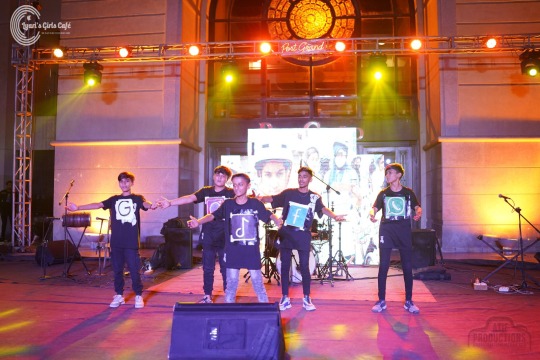

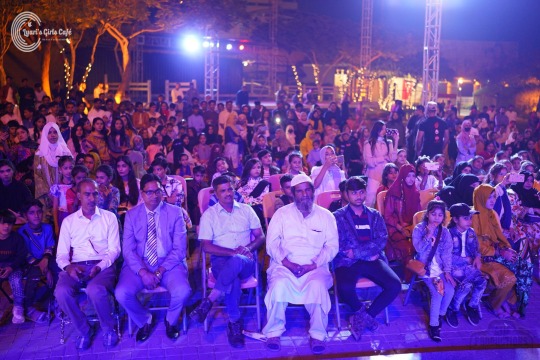
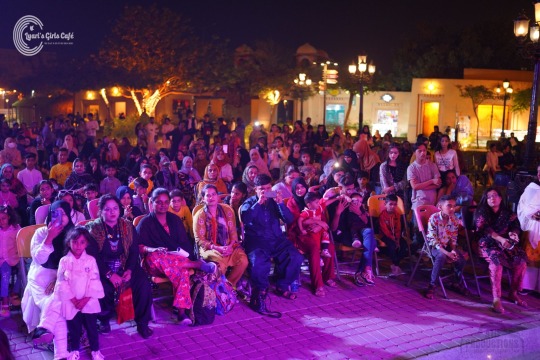

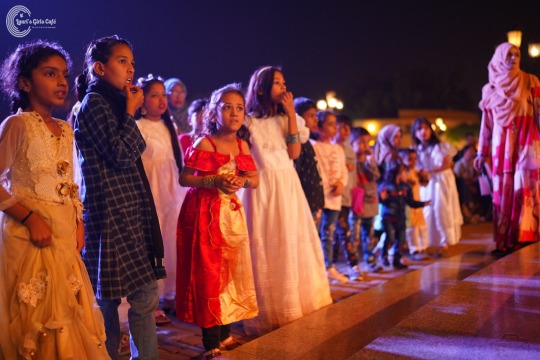

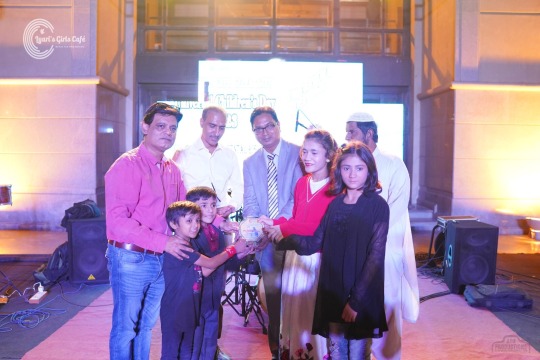
Every day is Children’s day. In connection with Children's Day, an event was organized at Port Grand Karachi under the auspices of Lyari Girls Cafe Foundation.
A ceremony was held at Port Grand Karachi organized by Lyari Girls Cafe Foundation in connection with Children's Day. Chief guest Altaf Hussain Sario Deputy Commissioner South Karachi participated in the event. The Children's Day event was organized in support with ARADO's #LocaltoGlobal, #TDH and #PortGrand.
Hundreds of children along with their parents and women, elders and youths participated in the event.
.
.
.
.
.
.
.
#LyariGirlsCafe #LGCF #GlobalActionMonth #iyn #Children #LittleGreenSteps #FutureEcoLeaders #Lyari #Karachi #Pakistan #Educational #PitStops #ArtForCause #Cleanup #Crew #young #environmentalist #surroundings #inspiring #positivechange #happykids #ChildrensEnvironmentalRights #FutureEcoChampions #GreenWalkTogether #childrensday #happychildrensday #kids #childhood #celebration #goals #success #growth #Storytelling #trend #viral #instagood #instagram #smile #special
3 notes
·
View notes
Text
A dive into the archives
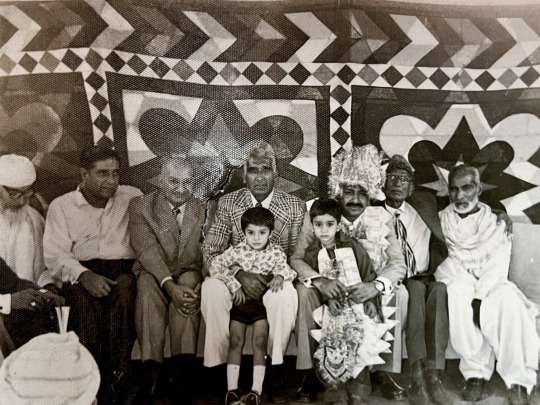
Image 1: My maternal family at a wedding Dawat in post-partition Lahore, Pakistan (1977) The groom, who happens to be my Mamoo (maternal uncle) is adorned with shiny headwear and garlands sewn with cash notes. The colourful, patterned shamiana tent veiling the Dawat is a common occurrence in banquet halls even today. Dawats also serve as the ideal opportunity to get multiple family members and kin together for a group portrait, a crucial and vital method of documenting a visual record of humans that are often overlooked and erased from history and whose lived experiences have been minimized and rendered invisible by colonial hegemonies.
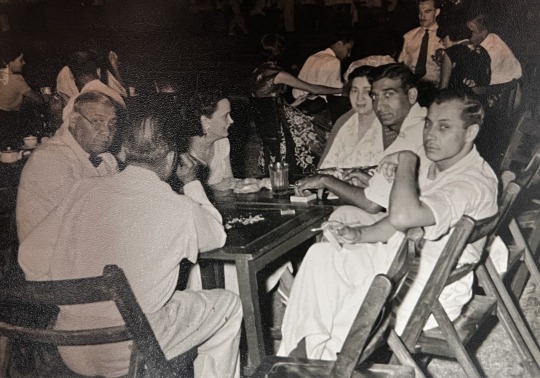
Image 2: My maternal grandfather, F.D Chaudhry, a soldier in the British Army, hosting his British and German friends at a small Dawat in post-partition Lahore, Pakistan (1950) These are foreign families that chose to remain in Pakistan after the partition of the country from India, but have since returned to their respective homelands.

Image 3: My mother, Mohtarma Rubina Magsi, celebrating Shab-e-Barat, a major Dawat for the global Muslim community, honoured in the month of Sha'ban in the Islamic calendar (1980s) After finishing our prayers in new clothes, we would head outside into the garden to play with sparklers and light little diyas (oil lamps made from clay) all around the boundary walls of our home. The deceased are honoured on this day and the festival is celebrated in unique ways in Muslim countries around the world, depending on the country and culture.
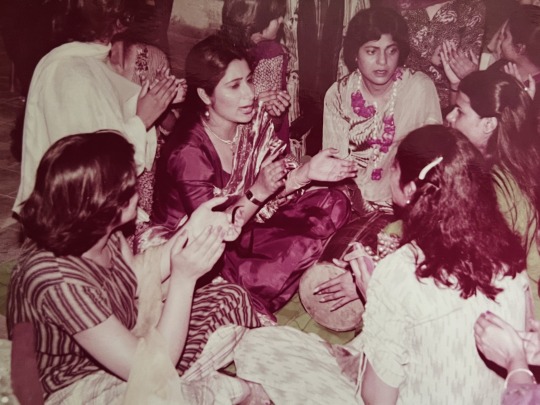
Image 4: Mohtarma Rubina Magsi surrounded by her singing and clapping women friends ( Late 1970s) They are taking turns playing the dhol (drum). Often a sturdy, silver spoon is also hit onto the center of the dhol to add depth to the music. Some guests may even reach for a dufflee (tambourine) and clap it against their henna stained palms. The music can range from orally transmitted folk songs to Bollywood hits from across the border. Healthy competition is fostered as guests attempt to outdo one another with an impressively long array of memorized songs.
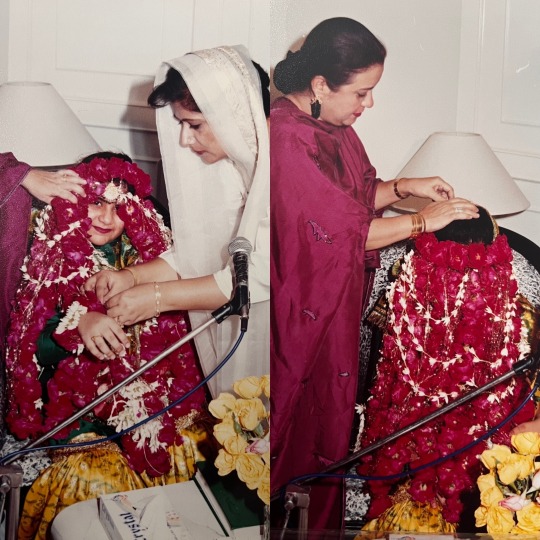
Image 5: A duo collage of community elders veiling my hair and face with heavy garlands of vibrant, red rose flowers to mark the Rasm-e-Ameen, a Dawat hosted to honour the completion of formal Quranic education. The customary prayers are followed by a large buffet style banquet feast. (1993)
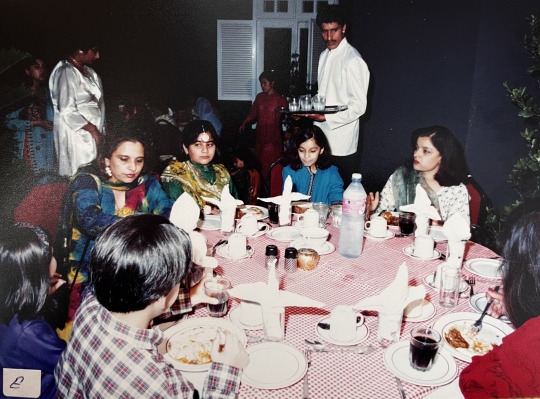
Image 6: Guests enjoying their banquet dinner on a round table after the Rasm-e-Ameen. A waiter holding a tray with glasses watches over the banquet tables to ensure the guests are looked after. (1993)
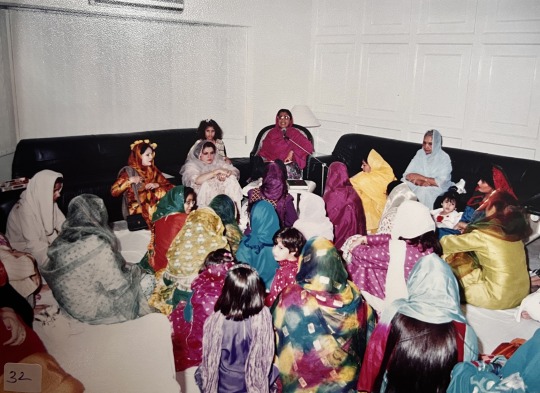
Image 7: A women prioritized Dawat-e-Milad in praise of Prophet Muhammad, hosted at our home in Karachi, Pakistan. Though veiling of the hair is not an imposition in Pakistan, even at women prioritized religious, cultural and spiritual events such as these, both Muslims and non-Muslims loosely cover their hair momentarily, out of respect. (1995)
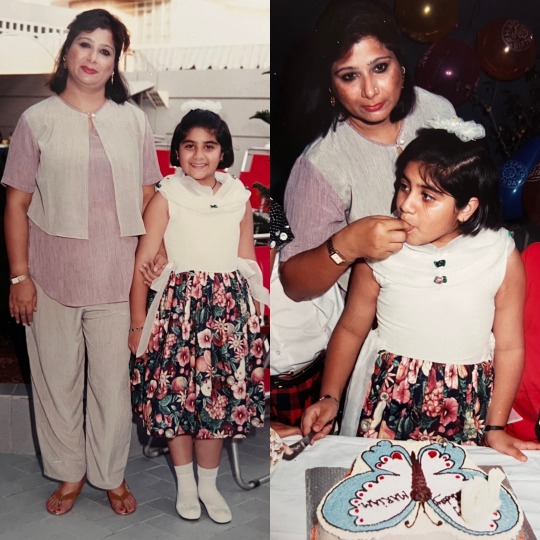
Image 8: A birthday banquet to honour the day I was born. It is interesting to note, that while traditional, cultural garments are prioritized for certain events, like the Dawat-e-Milad, Rasm-e-Ameen or a wedding Dawat, western clothing, games and food is often engaged at Dawats such as birthdays and graduations. (1994)
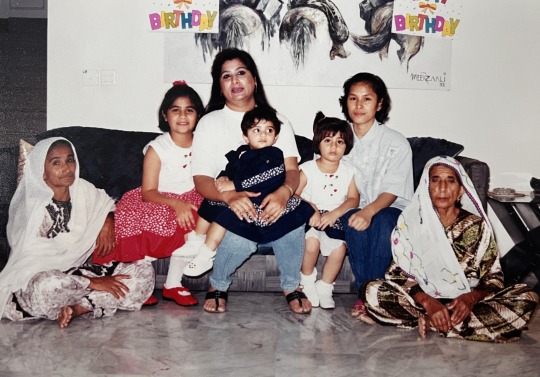
Image 9: Generation after generation, the visibility of women in documentations of family life has increased. This is a family photograph taken on my birthday Dawat (1993) with my mother at the center, surrounded by children, and caregivers from the Philippines and our ancestral lands, Jhal Magsi, Balochistan. I was truly raised by a multi-generational, diverse village of people from all corners of the world. While some members of our family are wearing western clothing, others are dressed in traditional, cultural garments and have chosen to veil their hair.
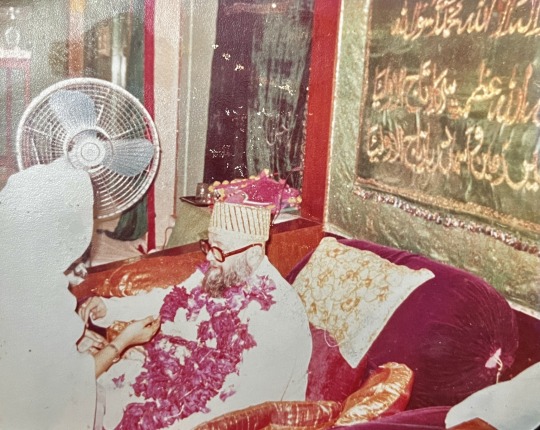
Image 9: A spiritual, Sufi Dawat at the Taji Shrine in Meva Shah, Karachi. My mother is adorning our family's Sufi saint (Baba Anwar Shah Taji) with heavy garlands of red roses. (1980) While flowers are given feminine traits in various cultures around the world, in many South and Central Asian countries, such as India, Pakistan and Nepal, flowers are a gender neutral way of showing love and adoration through the art of ornamentation. After the customary Sufi rituals are complete, the congregation gathers side by side on the floor to consumer Langar, a meal that is served to everyone in attendance, at no cost. The Langar menu can vary from week to week, consisting of curries, rice dishes, naans and sweets, and no one is turned away from the doors of the shrines when Langar is served. Whether cis or trans, male or female, able or disabled, rich or poor, local or foreign, everyone is welcome here. In some shrines the genders are segregated.
Most Dawats in Pakistan mark important life milestones, like births, birthdays, weddings, graduations and are also influenced by cultural traditions and religious rituals, varying from household to household, depending on cast, clan, socioeconomic standing, province and religion.
There are some motifs and symbols that make a recurring appearance, era after era, such as rose petals and night blooming jasmine flowers, shamiana tents, cauldrons of Biryani, unisex garlands and head coverings made with either cash or flowers (or both), various forms of veiling (with both textiles and flowers), the dhol (drum) and of course, endless cups of Chai. Of the various significant Dawats that take place throughout the year, apart from events like birthdays and weddings, certain religious Dawats like Shab-e-Baraat (a major festival for Muslims celebrated in the month of Sha'ban, the eighth month of the Islamic calendar) Rasm-e-Ameen (formal completion of Quranic education), Urs (death anniversaries of Saints and Mystics), Milad (events fostered in praise of Prophet Muhammad) and Niyaz (Meditative chanting and prayers followed by distribution of food amongst the needy) also encompass specific rituals and customs. As visible in the archives, there was also a healthy mix of retaining local, familial customs and traditions, while also engaging with clothing, games, food and rituals from cultures outside of Pakistan.
For example, every New Year’s Eve, it was customary in our home to consume a large feast of purely Filipino food, made by our caregiver, Flordeliza Sauza. Right as the clock would strike midnight, you best believe, we would be shoving Siopao, Pansit and Chicken Adobo with garlic rice into our excited, hungry mouths. Similarly, Chinese food was also a staple, especially at birthday parties and weddings. My wedding Dawat feast in Karachi included several desi Kababs, Curries and Puloas originally devised in the royal kitchens of India, but many Chinese dishes were also served, such as Chicken Manchurian, Beef Chilli, Shrimp Dumplings and Vegetable Fried Rice. This is reflective of a society that is open to global influences.
Women have been at the forefront of cultural continuity in Pakistan, as well as in the diaspora. Religiously inclined Dawats, such as the Milad and the Rasm-e-Ameen often take place in women prioritized spaces, with multi-generational guests in attendance, fostering community and togetherness. One of my favourite moments from the Milad Dawat has to do with guests being showered with delicate, soft sprinkles of rose water, while standing side by side, singing and praying in a unique moment of women's solidarity. In some Milad Dawats, guests are not only showered with droplets of Rose Water, they are also covered with petals from red roses, making the experience truly immersive and embodied.
2 notes
·
View notes
Text
You make me do
Fatima Jinnah
Known as Madar-e-Millat or mother of the nation. She was crucial in the Pakistan's fight for independence.
And founded Jinnah Medical College for Girls.
Too much labour
Yasmeen Lari
Pakistan's first female architect. She went from designing shiny corporate structures such as Karachi's finance and trade center.
To helping build shelters for those affected by earthquakes (since 2005) with the resources they had available.
All day everyday
Zennat Haroon Rashid
Founding member of the Woman's national guard in Pakistan.
Her daughter created the "Zeenat Haroon Rashid Writing Prize for Women" in her honour. Which works to support women who want to pursue writing as a career.
Therapist Mother Maid
Azra Haq
A member of the Woman's national guard in Pakistan who helped to support and aid women who had been abandoned during the partition.
Nympth and a virgin
Sheherezade Alam
A renowned ceramist who themed her work around the earth. Founder of LAAL, an artistic movement to promote and preserve Pakistani art and culture.
Nurse than a servant
Mehnaz Rafi
One of the first members of the Woman's Action Forum (WAF) who worked to help woman fight for their rights.
Just an apandage
Madeeha Gauhur
Pakistani actress, playwright and director. Founded the Ajoka theatre in 1984, which stages social themes in theatres, on the street and other places in the public.
Live to attend him
Bapsi Sidhwa
Pakistani world renowned author, essayist and playwright. Well known for her novels which reflect her personal experiences of Partition, her life in Lahore, diasporic stories, identity etc.
So that he never lifts a finger
Begum Ra’ana Liaqat Ali Khan
The 1st First Lady of Pakistan, became the first Muslim female delegate to United Nations. In 1954, she became the first woman ambassador of Pakistan and was sent to Netherlands. In 1973, she became the first female governor of Sindh and later on, the first Chancellor of Karachi University and Sindh University.
Begum Ra’ana was awarded Nishan-e-Imtiaz. She was also given Order of Merit of Italian Republic, Order of Orange Nassau, Netherlands and the UN Human Rights Award 1978.
24/7 baby machine
Dr Sania Nishtar
She is the Special Assistant to the Prime Minister of Pakistan on Poverty Alleviation and Social Protection and the Leader of Global Health and Sustainable Development.
Since 2018, Dr Sania has been the leader of the poverty reduction program in Pakistan called Ehsas, which strives to provide livelihood and improve the social situation of many people in the country.
So he can live out
Muniba Mazari Baloch
Due to suffering a spinal cord injury at 21, Muniba used it as fuel to encourage women and girls that have experienced discrimination or violence to not fear or fight the pain.
She is as Pakistan’s first National Ambassador.
His picket fence dreams
Asma Jahangir
Pakistani politician, lawyer, and human rights activist. She chaired the Bar Association of the Supreme Court. She has won numerous awards for her work on human rights, including the Martin Ennals Award.
It's not an act of love if you make her
Tahira Qazi
A beloved Pakistani principle who was held hostage at her school with her students by terrorists.
Although she had the opportunity to escape and save her own life, she chose to save her students.
"They are my children and I am their mother.”
She fought for them but unfortunately lost her life that day, on December 16th 2014.
You make me do too much labour
Malala Yousafzai
Pakistani activist for women's rights to education. Fighting for her right to education since she was a child, getting shot in the head by the Taliban for her efforts.
She continues to fight and was the youngest person to be awarded a Nobel peace prize.
#women's history month#Pakistani#Pakistan#Desi#Pakistani women#Pakistan women#Women's rights#pakistan culture#Artists#Writers#Playwrights#Tw death#Tw shooting#South Asia#paris paloma
12 notes
·
View notes
Text
Discover the Perfect Blend of Luxury and Convenience: Flats in Shaikpet Hyderabad
Finding the ideal home that offers both comfort and convenience can be challenging, but the flats in Shaikpet Hyderabad redefine modern living. Nestled in one of the city's most sought-after locations, these homes combine cutting-edge amenities, elegant interiors, and unmatched accessibility. Whether you’re searching for 3 BHK flats for sale in Shaikpet Hyderabad or looking for a valuable real estate investment, this vibrant community has it all.
Location That Connects You to Everything
Shaikpet's prime location ensures that all essential services and popular destinations are within arm's reach. These apartments in Shaikpet Hyderabad offer easy access to:
Educational Institutions: Top schools like Delhi Public School and G. Narayanamma Institute of Technology & Sciences.
Healthcare Facilities: Leading hospitals such as Care Hospitals and Sunshine Hospitals.
Shopping and Dining: Just minutes from D-Mart, KFC, McDonald’s, and the renowned Karachi Bakery.
Business Hubs: Key IT parks like Divyasree NSL Orion IT Park and Raheja IT Park are within a short drive.
This connectivity makes the location ideal for families, working professionals, and investors alike.
Unmatched Amenities for a Modern Lifestyle
The flats in Shaikpet Hyderabad come with a host of premium amenities designed to cater to every lifestyle. Highlights include:
A swimming pool for relaxation and recreation.
A state-of-the-art open-air gym and fitness center for health enthusiasts.
Cycling tracks and landscaped rock gardens for outdoor enjoyment.
A dedicated children’s play area to keep the little ones active and entertained.
24-hour security, power backup, and ample car parking for peace of mind and convenience.
These features make the community a self-contained hub for residents, offering a fulfilling and vibrant lifestyle.
Sophisticated Interiors Designed for Comfort
Step into these luxurious 3 BHK flats for sale in Shaikpet Hyderabad, and you’ll immediately notice the attention to detail. Built with earthquake-resistant RCC M25 grade structure, these homes ensure safety and durability.
Living Spaces: Elegant Italian marble flooring in the living and dining areas adds a touch of grandeur.
Bedrooms: While the master bedroom boasts cozy wooden flooring, the other bedrooms feature premium vitrified tiles.
Kitchen: Thoughtfully designed with a granite countertop, stainless steel sink, and provisions for modern appliances like a water purifier and chimney.
Bathrooms: Fitted with high-quality fixtures, including pedestal wash basins and hot and cold mixers, ensuring a spa-like experience.
Smart Electrical and Connectivity Features
These apartments in Shaikpet Hyderabad are equipped with advanced electrical setups for modern living. Key features include:
Fire-retardant concealed wiring for enhanced safety.
Provisions for air conditioners, geyser connections, and kitchen appliances.
Ready-to-use cable TV and internet connections in every flat.
These features make your home tech-ready and future-proof.
Why Invest in Shaikpet Flats?
The 3 BHK flats for sale in Shaikpet Hyderabad offer not just a home but a lifestyle upgrade. The area’s rapid development and increasing property demand ensure high returns on investment. Whether you choose to reside or rent out your property, the growing popularity of Shaikpet makes this a wise financial choice.
Your Dream Home Awaits
If you’ve been waiting for a property that combines luxury, connectivity, and a family-friendly environment, the flats in Shaikpet Hyderabad are the answer. Don’t miss out on this opportunity to secure your dream home. Schedule a visit today and take the first step toward experiencing unparalleled modern living.
0 notes